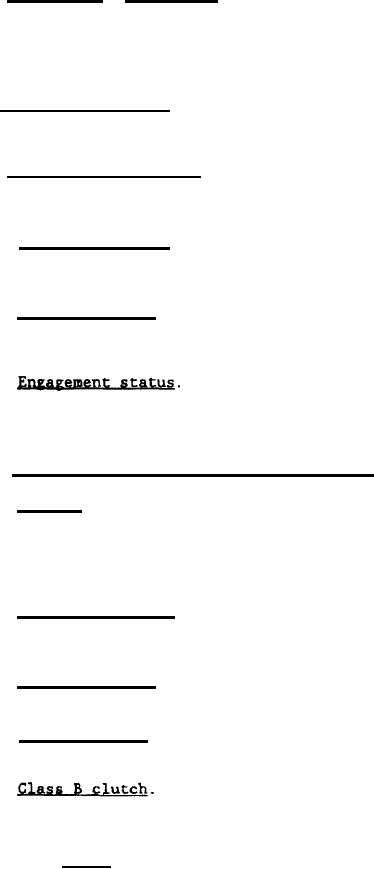 |
|||
|
|
|||
| ||||||||||
|
|  MIL-C-18087A(SH)
3.9.7 Synchronizing mechanism. The speed synchronizing elements of the
clutch shall be of the friction type and shall be constructed to operate in oil.
The torque required for synchronization shall be as specified (see 6.2). If the
clutch is hydraulically engaged or disengaged, provision shall be made for
positive separation of the clutch disks when oil pressure is relieved,
3.9.8 Balking mechanism. A positive, mechanical balking mechanism may be
used to sense synchronization of shaft speeds and prevent premature engagement of
the coupling teeth.
3.9.9 Actuation and control. The clutches shall be actuated pneumatically
or hydraulically. The method of supplying the actuation pressure shall be as
specified (see 6.2).
3.9.10 Oil for actuation. Unless otherwise specified (see 6.2), oil for
actuation and cooling of a hydraulic clutch shall be the same as that used for
lubricating the associated equipment.
3.9.11 Cl utch controls. Clutch control shall be by means of a directional
control valve or mechanical linkage. Valve or linkage shall be located as
specified (see 6.2).
Clutch position shall be shown locally and
3.9.12
remotely as approved by the contracting activity. Electro, mechanical, or
proximity switch equipment as approved by the contracting activity may be used to
show the clutch position.
Type VI positive drive overrunning cl utch.
3.10
3.10.1 General. Positive drive overrunning clutches shall be
constructed to
engage driving and driven shafts under any speed between zero r/rein
and maximum
design engagement speed, at the instant that the speed of one shaft
overtakes that
of the other. The clutch shall be constructed to disengage driving
and driven
shafts so that either shaft may rotate freely relative to the other
shaft.
3.10.2 Oil for actuation. Unless otherwise specified (see 6.2), oil used
for the hydraulic servomechanism shall be the same as that used for lubricating
the associated equipment.
3.10.3 Clutch controls. Clutch control shall be by means of a directional
control valve, located and operated as specified (see 6.2).
3.10.4 Class A clutch. Class A clutches shall be constructed for automatic
engagement and disengagement as specified in 3.10.1.
3.10.5
Class B clutches shall incorporate a remotely
controlled hydraulic or pneumatic servomechanism to provide the axial force
required for engagement or disengagement as specified in 3.10.1.
3.10.6 Engagement. The driving and driven shafts shall be connected by
means of a gear-type coupling constructed to transmit full power torque. A
helical sliding spline shall provide for the movement of the clutch sleeve into
engagement with the hub.
23
|
|
Privacy Statement - Press Release - Copyright Information. - Contact Us |